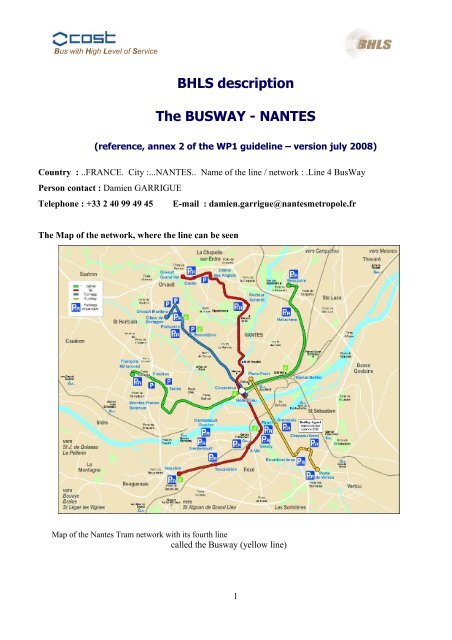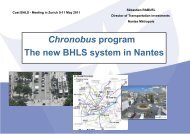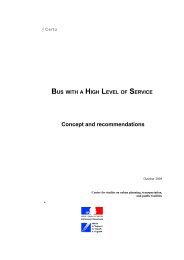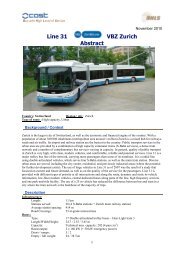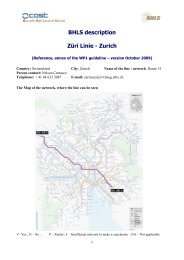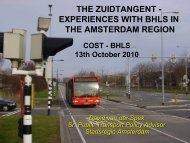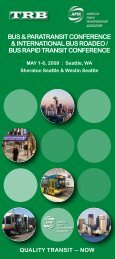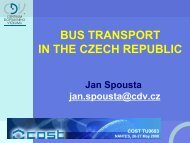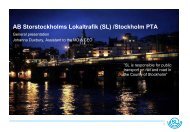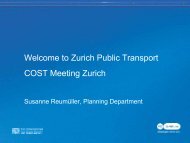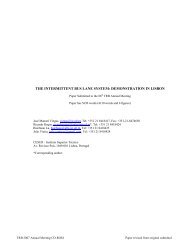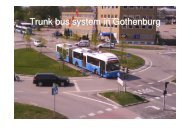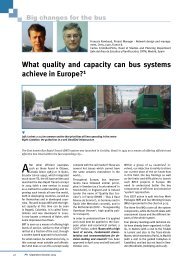You also want an ePaper? Increase the reach of your titles
YUMPU automatically turns print PDFs into web optimized ePapers that Google loves.
Bus with High Level of Service<br />
BHLS description<br />
The BUSWAY - NANTES<br />
(reference, annex 2 of the WP1 guideline – version july 2008)<br />
Country : ..FRANCE. City :...NANTES.. Name of the line / network : .Line 4 <strong>BusWay</strong><br />
Person contact : Damien GARRIGUE<br />
Telephone : +33 2 40 99 49 45 E-mail : damien.garrigue@nantesmetropole.fr<br />
The Map of the network, where the line can be seen<br />
Map of the <strong>Nantes</strong> Tram network with its fourth line<br />
called the Busway (yellow line)<br />
1
Bus with High Level of Service<br />
- Yes ; N – No ; P – Partial ; I – Insufficient network to make a conclusion ; NA – Not applicable<br />
1 – The urban and governance context<br />
The main data of the urban area context<br />
Answer<br />
If needed: some<br />
comments or<br />
explaination<br />
Number of communities 24<br />
Number of inhabitant of this urban area 570 000<br />
Total surface of this urban area<br />
Density (and if possible density of the downtown)<br />
PT market split rate<br />
15% of all modes<br />
Number of PT trips / inhabitant / year 176<br />
Average of trips / Km :<br />
- all modes<br />
- BHLS<br />
- Other main mode<br />
Operating cost coverage rate (all PT modes)<br />
Including walking<br />
and cycling modes<br />
The background : context of the project implementation and decision<br />
process.<br />
What was the basis for the stimulus of the project?<br />
- Is it a part of a mobility master plan ?<br />
- Is it an upgrading existing bus line ?<br />
What are the main objectives at the level of the whole urban area ?<br />
Who was the promoter/initiator of introducing the BHLS project?<br />
Main dates of the project<br />
- creation of the mobility master :<br />
- feasibility studies:<br />
- decision to proceed:<br />
- start construction:<br />
- end construction:<br />
- opening year:<br />
Was there a system choice debate between BHLS / tram system /<br />
metro system ?<br />
Have there been in the past (70-80-90) trials to implement an<br />
,,upgraded’’ bus line or have there been projects that could be seen as<br />
2<br />
Answer<br />
<br />
N<br />
<br />
<br />
If needed: some comments<br />
or explaination<br />
efficiency<br />
<strong>Nantes</strong> Metropole – political<br />
decision<br />
End of December 2006<br />
6 November 2006<br />
Transformation from a<br />
tramway line project<br />
initially towards a BHLS<br />
line, for capacity/budget<br />
reasons<br />
And sold as a system that<br />
can become a tram line in<br />
the future<br />
Chronobus lines in the
Bus with High Level of Service<br />
forerunners of BHLS? network since 2003<br />
The BHLS communication / marketing process<br />
What were main difficulties to overcome when trying to implement ?.<br />
Were they (with some short explanation if yes):<br />
- technical ?<br />
- political ?<br />
- social ?<br />
- economic ?<br />
How were user need assessed/collected?<br />
- surveys done<br />
- process to talk<br />
To know if user groups were requested for designing the project, and how it<br />
has been managed.<br />
- in case remarks taken in account:<br />
Specific elements (arguments) that made the project adopted<br />
The main socio-eco key indicators used to justify the BHLS systems, what<br />
were they ?<br />
Integration in land development ?<br />
Cost of the global project / km (including P+R, interchange stations, …)<br />
How was the project financed?<br />
Source of funds (results in % )<br />
- Public funds (state, local authority)<br />
- Part of PPP<br />
- Financement by land development<br />
Tendering: was the BHLS project tendered and if yes was it done like a turnkey<br />
(infra+vehicles) at the same time or vehicles separated?<br />
Other (describe)<br />
<br />
7,5 M€<br />
<br />
N<br />
N<br />
<br />
Firstly, it was called a<br />
“tram-bus” project, then<br />
the Busway, but always<br />
the 4 th tram line<br />
Works constraints in a<br />
major traffic artery<br />
Public meetings, opened<br />
registers<br />
More information than<br />
association of users –<br />
remarks token into account<br />
Efficiency, implementation<br />
and costs<br />
Cost/users<br />
Urban planning adapted in<br />
the area<br />
Local authority, Europe<br />
(Civitas) and region<br />
(nothing from the state)<br />
Infra, vehicules and<br />
operation separated<br />
Network concerns<br />
Is it a main route of the network? Considered as a tramway<br />
line<br />
Is it a feeder route to the heavy mass transit systems?<br />
N<br />
Number of connecting point with the structuring network<br />
1 With the tram line 1<br />
Existence of an integrated “network” of several BHLS routes<br />
N<br />
Not yet - Planned<br />
Number of BHLS lines<br />
1<br />
Do provide the network map with the BHLS lines<br />
<br />
Do provide few photographs of the BHLS system<br />
<br />
3
Bus with High Level of Service<br />
Has the non-BHLS network changed because of BHLS adoption?<br />
Have you an integrated fare collection system?<br />
Have you an integrated information system?<br />
<br />
Re-organisation of the bus<br />
network around the line ;<br />
some bus lines feed the<br />
Busway<br />
4
Bus with High Level of Service<br />
2 – All components (first box)<br />
Features and attributes of the BHLS<br />
If needed:<br />
some<br />
comments or<br />
explaination<br />
Running ways<br />
Total length of the corridor(km)<br />
Bus lanes on highways (km or percentage)<br />
Segregated bus lanes or bus-only roadways (km)<br />
Partly in pedestrian streets (km)<br />
Way 1<br />
(to the<br />
centre)<br />
Way 2<br />
(from<br />
the<br />
centre)<br />
6,9 6,9<br />
0 0<br />
5,8 6,2<br />
Mixed traffic (km) 1,1 0,7<br />
Location of bus lanes (km or %) : - center<br />
4,92 4,78 Two ways<br />
- kerb-side<br />
0,93 0,93<br />
- - contra flow<br />
N 0,3<br />
Type of bus lane : - one way<br />
- two ways<br />
N<br />
N<br />
0,4 0,62<br />
5,4 5,4<br />
Guided bus way (length in km) N N<br />
Dedicated central lane with and without central island<br />
types of protection from intrusion of other traffic<br />
Flexible dedicated lane (alternative in a one-way; alternative in concordance with<br />
the situation, with schedules; …)<br />
Hour of operation of bus lanes<br />
Bus lanes or dedicated lanes shared with other users<br />
- Tram lines<br />
- Conventional buses lines<br />
- Coaches<br />
- Taxi<br />
- Bicycle<br />
- HOV<br />
- Emergency vehicles<br />
5<br />
<br />
N<br />
N<br />
N<br />
N<br />
N<br />
N<br />
<br />
<br />
N<br />
N<br />
N<br />
N<br />
N<br />
<br />
Heightened<br />
plate form (14<br />
cm) with<br />
particular curb<br />
stones<br />
Except in a<br />
short section
Bus with High Level of Service<br />
Type of construction<br />
Type of surface material on running ways<br />
Different color<br />
Heavy<br />
structure<br />
High modulus<br />
asphalt with<br />
specific<br />
colour<br />
Grade-separated intersections (nb)<br />
N<br />
N<br />
At grade intersections (nb)<br />
Type of signalisation (at intersections, other,…)<br />
26 26 12<br />
Roundabouts<br />
crossed in the<br />
middle<br />
Tramway<br />
signals<br />
Specific Tunnels or specific bridges for the lane (km)<br />
N<br />
N<br />
Width of bus lanes: - one way min/max (m)<br />
- two ways min/max (m)<br />
Total length of feeder lines (km) (if applicable)<br />
3,5 / 4,5<br />
6 / 7,5<br />
8 bus lines<br />
6
Bus with High Level of Service<br />
Was road space capacity taken away (suppressed). If yes, how much and where?<br />
Other (describe) :<br />
<br />
Divided by 2 on the<br />
major part of the itinerary<br />
(high way converted in<br />
urban boulevard)<br />
Stations / Bus stop<br />
Number of stations 15<br />
Type of stations: - opposite<br />
- central<br />
- off set<br />
average station spacing (m)<br />
Number of stations with passing lanes<br />
14<br />
1<br />
500<br />
N<br />
Platform curbs : - height (cm)<br />
- type (shape, material)<br />
Platform: - length (m)<br />
- width (m)<br />
27<br />
bevelled, polished granite<br />
curb<br />
24<br />
3 More than 3 meters for<br />
one…<br />
Distinctive pavement treatment at station (concrete for instance) Percolated asphalt with<br />
concrete grout<br />
7
Bus with High Level of Service<br />
At-level boarding and alighting<br />
<br />
These stations are:<br />
- open station<br />
- closed station with pre-paiement<br />
Average horizontal and vertical gaps (cm) H : 5<br />
V : 5<br />
<br />
N<br />
Automatic mini ramp (30<br />
cm) at doors 2 and 3 to<br />
link the plate-form and<br />
the vehicle<br />
How many major stations, with interchanges ?<br />
Modal integration at these major stations : - P+R<br />
- bicycle parking<br />
- taxi stations<br />
- easy transfers<br />
- other (to be precise)<br />
Modal integration at terminal station : - P+R<br />
- bicycle parking<br />
- taxi stations<br />
- easy transfers<br />
- other (to be precise)<br />
Improvements to nearby public space<br />
Specific design of the stations (for a specific branding of the line)<br />
Pre-board fare collection at station : - ticketing vending machines<br />
- validation<br />
- fare control<br />
Dynamic information at station<br />
o type of screen:<br />
o destination<br />
o the waiting time<br />
o on disturbances (what and how)<br />
o other<br />
Comfort for the customers<br />
- is there shelters and seats at each station<br />
- is there lighting at each station<br />
- is the waiting space calculated in accordance to the ridership the<br />
8<br />
<br />
<br />
N<br />
<br />
<br />
<br />
N<br />
N<br />
<br />
<br />
<br />
<br />
<br />
N<br />
N<br />
<br />
<br />
<br />
<br />
<br />
Extensions planned<br />
On-time information<br />
Planned<br />
On-time information<br />
Treatment façade to<br />
facade<br />
The same specific design<br />
at all stations (dimension<br />
and shelters)<br />
One on each platform<br />
inspectors
Bus with High Level of Service<br />
station (precise if yes)<br />
Other services at station (describe)<br />
P+R : - number<br />
- number of spaces in total<br />
- is it a specific form of payment for the bhls user?<br />
N<br />
4<br />
1100<br />
They were full some<br />
months after the opening<br />
Other (describe) :<br />
Vehicle<br />
Is it a dedicated fleet?<br />
<br />
Number of vehicles (age average in years) 20 1,5 years<br />
Vehicle type and length (m) 18 m CNG articulated bus<br />
Vehicle capacity (seats / standing 4 pass/m2 / total))<br />
Specific design for this BHLS route<br />
37 s<br />
157<br />
total ?<br />
<br />
Max 110 pass/bus<br />
(reality) ?<br />
tram-like sliding<br />
doors<br />
Animated line diagrams<br />
Screens providing<br />
connection times with<br />
the other lines<br />
A closed area for the<br />
driver<br />
Mini exit ramp doors<br />
2 and 3<br />
Soft and indirect<br />
lighting<br />
Comfortable seats<br />
Insulation with doubleglazed<br />
windows<br />
Fuel type used in trunk vehicles CNG As all the bus fleet<br />
running in the network<br />
Level of emission regarding the Euro regulation (Euro 3, 4,…)<br />
Euro4<br />
Location of doors (left, right, both sides), width and number of doorways Right 3 full doors<br />
1 half door<br />
Multiple-door boarding<br />
<br />
Multiple-door alighting<br />
Percentage of low floor (without steps) 100<br />
height of floor above ground (in cm) 32<br />
Disabled people features (specify) Automatic ramp at doors<br />
2 and 3<br />
What is the number of wheelchair places per bus (1, 2 or more..) 2<br />
9
Bus with High Level of Service<br />
Ramp for wheelchairs (Electric or manual) Electric and systematic<br />
At which door is the ramp mounted (door 1 closest to driver) 2 and 3 Wheelchair places near<br />
door 2<br />
If you have electric ramps, of what type are they ? (classical with a long flap,<br />
or ,,mini-palletes”)<br />
mini-ramp (30 cm)<br />
Precision Docking System or type of guidance system, if applicable N Contact guidance :<br />
tire/granite curb<br />
on-board fare collection and verification (purchase on board, validation on board, N Validation on board. No<br />
role of the driver)<br />
role for the driver – on<br />
board inspectors<br />
Air conditioning / HVAC systems N Double glazed windows<br />
Dynamic information on board<br />
- type of screen:<br />
- next stop / terminus:<br />
- running time until terminus<br />
- disturbances<br />
- advertisements<br />
- waiting time of the next connected services of the trunk network<br />
- other:<br />
<br />
<br />
<br />
- Visual and sound next<br />
stop announcements<br />
- animated line diagrams<br />
- Screens providing<br />
connection times with<br />
other lines<br />
Number of feeder vehicles 20<br />
Year of last tender for HLS-vehicles 2005<br />
Size of tender in number of vehicles 20<br />
Ratio: price of one BHLS vs price of one CNG articulated 18m bus 1,2<br />
If a maintenance contract is included, for how long (years)<br />
If a guarantee period is included, for how long (years)<br />
Possibility to enter bikes in the vehicle<br />
Other (describe):<br />
N<br />
<br />
<br />
One year, when all<br />
problems solved<br />
Early in the morning and<br />
late in night – Sundays<br />
and summer holidays<br />
Intelligent Transportation Systems (ITS)<br />
( or operation management tools)<br />
System management through centralised control centre, utilising automatic<br />
vehicle location system (AVL) – (add information on technology)<br />
Is AVL used differently for the bhls line than the other bus lines ?<br />
High-quality customer information, e.g. :<br />
- clear maps at station<br />
- signage,<br />
- real-time information displays on board<br />
- real-time information displays at station)<br />
- web site<br />
10<br />
<br />
<br />
<br />
<br />
<br />
<br />
Common centre for tram<br />
and bus; Localisation<br />
with GPS, radio system<br />
with drivers, operators<br />
involved on perturbances<br />
information
Bus with High Level of Service<br />
Web or phone information system (real time)<br />
Is there a multimodal information system :<br />
- integration in the whole urban area ?<br />
<br />
<br />
<br />
Mobitrans<br />
Destineo<br />
Emphasis on prepaid fares with innovative technology<br />
- contactless systems<br />
- by mobile phone<br />
- other<br />
Where can the customers buy their tickets?<br />
Where do they have to validate?<br />
Fare- and physical-integration between routes and feeder services:<br />
- integration in the whole urban area ? <br />
Priority signal control at all intersections<br />
Driving aid signing for road crossings<br />
N<br />
N<br />
<br />
<br />
Paper magnetic tickets<br />
Outside the bus, at the<br />
station, like for the<br />
tram<br />
Inside the bus<br />
transponders that signal<br />
loop detectors (two times<br />
before, one time just after<br />
the crossing<br />
Enforcement control systems in order to protect the use of the dedicated lanes:<br />
N<br />
Security control systems<br />
- inside the vehicle<br />
- at station<br />
Collision warning systems (into the vehicle)<br />
Optic fibre along the line<br />
Integrated intermodal information<br />
Other (describe)<br />
<br />
<br />
N<br />
<br />
<br />
CCTV in buses and P+R<br />
CCTV at particular<br />
spots : 5 on the line<br />
Real time connexions<br />
information / waiting<br />
lights for feeder buses in<br />
interchange station<br />
Identity of the BHLS system<br />
Distinctive marketing identity for the system :<br />
- by a logo<br />
- by a name<br />
Distinctive bus among the other current lines<br />
Enhanced shelters :<br />
- with a distinctive brand ?<br />
- Is it done in accordance to the vehicles design?<br />
Distinctive colour for shelters and buses<br />
Key tools to protect in the long term the BHLS concept, the BHLS efficiency<br />
<br />
<br />
<br />
<br />
N<br />
<br />
<br />
Different colour and<br />
design<br />
Registered trademark<br />
11
Bus with High Level of Service<br />
Other (describe)<br />
After filling in this table, regarding your case studies, feel free to add and express some other specific<br />
components that at your mind have played or will play a key role in the system:<br />
3- The system performance ( 2 nd box)<br />
In terms of level of service / efficiency of the system<br />
If needed some<br />
explaination or<br />
comments<br />
Service span 19h30 From 5h am to 0h30<br />
am<br />
About the time table, possible web site link:<br />
http://www.tan.fr/<br />
Average peak headway per direction (minutes) 3’30<br />
Average non-peak headway per direction (minutes) 6’<br />
Average dwell time at stations (seconds) 15”<br />
Average commercial speed (km/h)<br />
- at peak hour<br />
- at off-peak if possible<br />
Are there point to point services or express services during the peak period (for<br />
commuters)?<br />
21<br />
21 23 on Sundays<br />
N<br />
Occupancy of P+R, B+R (availability of place until what time)<br />
Compliance of driver cars, taxis, bikes (respect of dedicated lanes):<br />
Other (describe)<br />
In terms of quality of service<br />
Is there a quality control in accordance with the European standard “EN<br />
13816” - June 2002 ?<br />
(the need to have an overview of the use of this standard)<br />
Indicators of regularity (reliability) that are used and their results (in terms<br />
of timetable)<br />
- about staying on schedule (or on headways):<br />
- about the running time variation (peak, off peak hours):<br />
(Precise how to measure these indicators, and the frequency of the<br />
measure, as well as the results)<br />
Are the travel times compared with car travel time ?<br />
12<br />
<br />
<br />
<br />
Services Quality NF<br />
EN 13816<br />
Punctuality criteria:<br />
Timetable : bus in [H ; H + 3min]<br />
Results achieved : 84% (on sundays)<br />
Regularity criteria<br />
Headways : bus in headways<br />
[h;h+2min]<br />
Good results achieved : 98% (week<br />
days)<br />
For more information see § 5.2 and<br />
report in annex
Bus with High Level of Service<br />
Indicators of availability that are used and their results (in term of vehicles<br />
X km or services)<br />
Quality control oversight<br />
- by an independent entity / agency ?<br />
- by the operator<br />
How are the main results?<br />
Passenger satisfaction measure<br />
- does it exist? What indicator?<br />
- How are the main results, evolution since the opening?,<br />
…<br />
- Customer complaints on this route:<br />
Is the measure of the quality reported each day (month, year) with<br />
transparency towards customers or public ? How ?<br />
Other (describe)<br />
<br />
<br />
<br />
<br />
N<br />
Part of criteria used in quality control<br />
In terms of services provided :<br />
99.95% in 2008 for the whole<br />
network<br />
AFNOR<br />
Punctual enquiries<br />
About the performance of the BHLS management<br />
Type of contract between operator and urban Authority and the way to<br />
manage the quality / performance targets<br />
Does exist “bonus / malus” in the contract?<br />
Is the operator specific for these lines ?<br />
with :<br />
- specific quality objectives<br />
- specific performances objectives<br />
Types and description of indicators used to measure the efficiency targets<br />
within the contract.<br />
Maintenance contracts<br />
- Who is responsible of the maintenance?<br />
o Infrastructure:<br />
o Buses<br />
o ITS:<br />
- Form of contract:<br />
<br />
N<br />
<br />
<br />
<br />
Public service delegation contract<br />
during 5 years.<br />
Quality criteria with 10 criteria<br />
monitored each<br />
One operator for the whole<br />
network<br />
As the other tramway lines<br />
Minimum requested : 90% on<br />
punctuality and regularity criteria<br />
described above.<br />
Objectif : 99%.<br />
See report in annex<br />
Same as the standard EN 13816<br />
« Service quality »<br />
See report in annex<br />
As a tramway line<br />
The operator itself<br />
Does the bus driver has customer oriented tasks ? (or closed cabin)<br />
Specific driver accreditation for the BHLS<br />
Drivers’ satisfaction with the actual driving conditions<br />
Independently operated and managed fare collection system<br />
Other (describe)<br />
N<br />
<br />
N<br />
Closed cabin<br />
For specific road signals and<br />
docking<br />
13
Bus with High Level of Service<br />
4- The system benefits (3 rd box)<br />
The benefits provided in terms of ridership<br />
If needed someexplaination or<br />
comments<br />
Is there a before and after evaluation report ?<br />
Average trips per day for the whole line:<br />
- ordinary weekday:<br />
- off-holiday period:<br />
System current daily ridership in passengers / km (P/k)<br />
- peak days<br />
- - annually<br />
25 000 + 25% for the two first years<br />
9,6<br />
7,1<br />
191 round trips/peak day<br />
757 834 km/year and 5 380 621<br />
passengers<br />
(2007)<br />
Real demand in one hour per direction (peak hour) 1900 /<br />
2000<br />
Number of passengers/m² in peak hour 3,4<br />
Main ingredients that bring new passengers<br />
Modal shift (cars to bus)<br />
In case the BHLS project improved a previous line, describe briefly this<br />
stage before, in term of level of ridership<br />
Efficiency, reliability, network<br />
organisation, road traffic<br />
constraints and P+R<br />
Around 30% of the Busway<br />
ridershift is coming from the car<br />
The benefits provided in terms of costs / revenues / safety... (for<br />
the decision makers)<br />
Is there a before and after evaluation report ?<br />
Total capital Cost (M€ TNI)<br />
- running ways<br />
- stations<br />
- vehicles (the fleet)<br />
- BHLS facilities (depot, workshop,…)<br />
- ITS<br />
- Other<br />
Average investment cost per KM<br />
Operating cost (€ x km) : in<br />
- the BHLS scheme operating costs:<br />
- the common bus operating costs:<br />
- the tram operating cost (if it exists):<br />
Be careful: we need to know in some words the content of this cost in order<br />
to have approximately a common definition of what is included in the<br />
operating costs, or<br />
Coverage of the operating cost (by the fares)<br />
- BHLS Revenue (all revenue)<br />
- BHLS operating cost<br />
Or by using the ratio trips / vehicle X km<br />
Fraud (gain or level of fraud – in %):<br />
- into the BHLS<br />
- into the whole network<br />
52<br />
9,2<br />
8 M€ /km<br />
All infrastructure costs<br />
20 vehicles<br />
? (drivers, maintenance and<br />
energy costs)<br />
Coming soon…<br />
2,3 M€<br />
?<br />
0,43€ / passenger<br />
Coming soon…<br />
14
Bus with High Level of Service<br />
Energy consumption per bus and per Km<br />
Energy consumption per passenger and per Km<br />
? Coming soon<br />
(+/- 78 m3 GNV/km)<br />
Safety (gain or level of safety) :<br />
- accidents per year<br />
- by category (death, serious injury, minor injury / damage only<br />
o inside the bus:<br />
o outside the bus:<br />
No death, but many falls<br />
inside the vehicle at the<br />
beginning, much less<br />
nowdays).<br />
One serious crash : the bus<br />
hit a motorcycle in a<br />
roundabout (disturbances<br />
during one hour)<br />
Security (gain or level of security for passengers and staff):<br />
- on vehicles<br />
- at station / stops<br />
In case the BHLS project improved a previous line, describe briefly this stage<br />
before, in term of cost<br />
Other (describe)<br />
The benefits provided for the customers / neighborhood (i.e.<br />
externalities)<br />
Are there any studies done comparing the situation before and after the BHLS<br />
implementation ? (in case, provide the references and shortly the main conclusions)<br />
Fees (ticket price) – single ticket in € 1,30 Most of the users are<br />
subscribers<br />
Average travel time (comparison with the car traffic): - by bus<br />
19min In peak hour<br />
- by car<br />
20 to 45<br />
Impact on the neighbourhood<br />
- availability of parking<br />
- increase of housing<br />
- shopping / economical activity<br />
- …<br />
Environmental benefits, such as<br />
- noise<br />
- pollution, … (if available)<br />
In case the BHLS project improved a previous line, describe briefly this stage<br />
before<br />
Other (describe)<br />
15
Bus with High Level of Service<br />
5- weakness and strength” of the whole approach of the system<br />
This paragraph should highlight the main weaknesses and strengths (or success factors) regarding all phases of the<br />
project in order to point the relevance of some components / organisation choice / design choice / … that play or could<br />
play a main role into the objectives achievement;<br />
5.1 On the urban / governance context<br />
The Busway project has been manage by <strong>Nantes</strong> Metropole exactly as a tramway project, dealing at the same<br />
time, step by step, with all components of the system. <strong>Nantes</strong> Metropole is in charge of PT, infrastructure and<br />
urbanism as well.<br />
This comprehensive approach of the « system » was very important and implies that vehicles, stations, traffic<br />
lanes, line identification and operating methods are dealt with in a coherent and sustainable manner. All<br />
studies were managed by an alone unit “mission Busway”<br />
This Busway was designed like the other tram lines, the main structuring network, which meets the same<br />
specific requirements in terms of efficiency and performance.<br />
One other success factor was the high politician support during all steps of the project; it was not easy (much<br />
more difficult than for the previous tram lines) to sell this new Busway to the concerned communities,<br />
whereas almost all other communities have a tram system that can be much more attractive and beautiful<br />
(with grass running ways for example)… hence one argument was that this Busway can easily be converted<br />
into a tram line inside the same space but when the ridership will achieve a sufficient level; The fear to get a<br />
“low level” tram seems now to disappear after the Busway opening.<br />
The urban context was rather easy, inside a wide space, except for two part, the terminus in the centre, into a<br />
protected ancient square (bad approach to the platform), and a narrow street outside the centre where a short<br />
one way dedicated section could be designed, given always the same efficient priority to the Busway.<br />
On an other hand, this project has decreased lot of car space, that engendered lots of difficulties during the<br />
works phase such as a higher congestion around this project.<br />
5.2 On technical choices of the whole system regarding the performance / benefits expected<br />
To achieve regularity and speed:<br />
The line reaches the same very good regularity as the tram lines due to the high level infrastructure.<br />
The operating speed is a little higher as expected (20 km/h was planed) : from 21 up to 23 km/h in<br />
off peak hours.<br />
One of the main reasons are the way to give the priority through each roundabouts with the same<br />
signalisation that have the tram, <strong>Nantes</strong> is a “roundabout” city.<br />
According to the standard,<br />
o the punctuality criteria is that your bus, to be on time, should leave the stop at [H – 59s ; H + 3min]<br />
when the line is monitored by timetable (on sundays with low frequency) : the results achieved are<br />
from 78,5% up to 87,8% of passengers are concerned “on time”.<br />
o The regularity criteria is that the bus, to be on time, should run in [h;h+2 min] when the line is<br />
monitored by headways (on week days with high frequency). The results achieved are much better,<br />
16
Bus with High Level of Service<br />
from 97,1% up to 97,6% of passengers are concerned “on time”. Those week days are the ‘pink days’<br />
into the table below. There are also green days on saturdays and blue days for sundays.<br />
The following table summarize the results for the whole year 2008 and the first trimester of 2009. The grey<br />
column shows the average (very good results : over the requested level of 90%), much more close to the<br />
“week days” results, as there are much more bus journeys into these days.<br />
The results are very good on week days, but less good on Sundays, because it seems more complicated to<br />
have busses on time when there is one bus every 15 minutes than to have the right headway between them<br />
when this headway is 4 or 5 minutes.<br />
Pink<br />
Week days<br />
Green<br />
Saturdays<br />
and holidays<br />
Blue<br />
Sundays and<br />
bank<br />
holidays<br />
Total<br />
Trimestre<br />
Results of the 4 last quarter 97,2% 96,7% 78,5% 96,7% 96,7%<br />
3rd quarter<br />
2008<br />
July 91,8% 97,4% 96,3% 92,7%<br />
August 95,1% 98,4% 94,5% 95,5%<br />
September 97,8% 99,0% 89,3% 97,7%<br />
96,0%<br />
Results of the 4 last quarter 97,1% 97,6% 80,9% 96,8% 96,8%<br />
4th quarter<br />
2008<br />
October 97,9% 97,3% 88,6% 97,6%<br />
November 98,3% 99,1% 96,4% 98,3%<br />
December 95,7% 91,4% 88,7% 95,1%<br />
97,0%<br />
Results of the 4 last quarter 97,1% 97,3% 83,6% 96,9% 96,9%<br />
1st quarter<br />
2009<br />
January 98,8% 99,6% 91,9% 98,7%<br />
February 98,7% 99,1% 82,2% 98,3%<br />
March 98,9% 97,6% 93,2% 98,6%<br />
98,5%<br />
Results of the 4 last quarter 97,6% 97,9% 87,8% 97,4% 97,4%<br />
Results about the regularity criteria data of the Busway, line 4.<br />
For more details about these operating issues, see the report in annex.<br />
To have the convenient vehicles capacity<br />
The line quickly drew substantial ridership, increasing from 17,000 users per day when it went into service,<br />
to 21,000 after four months and 26,500 after two years. The park-and-ride lots are always full, so that<br />
extension projects were done.<br />
Hence, we observe much more clients than expected. Owing to crowding at peak hours, the frequency has<br />
been brought down to 3-1/2 minutes in September 2007 (with the same fleet, as the speed was higher as<br />
expected). After that, larger capacity vehicles may be required in a shorter time than expected, such as biarticulated<br />
vehicles (24,5m). The route may also eventually be converted to a tramway line.<br />
To reach a good safety level:<br />
17
Bus with High Level of Service<br />
Drivers of private cars respect the dedicated lane, and they also understand and respect the traffic signals (the<br />
same as other tram lines). No major accident have been registered to date (only one), but a few passengers<br />
injuries have occurred inside the vehicles because of stronger breaks as buses are running faster (more than<br />
into tram or the common buses).<br />
It was rather difficult to convince the road safety Ministry to apply the tramway signalization to the Busway<br />
(non guided bus) as they want to maintain the same very good safety that can be observed for public<br />
transportation; a safety impact assessment have been made by end 2008, showing finally very good results<br />
regarding safety.<br />
One safety weakness can be observed at stations, due to the advertising faces on shelters which mask the<br />
visibility of the passengers, while they get out crossing the car lane, there is also a lack of understanding for<br />
car drivers in station (pavement color change).<br />
To reach a good level of investment costs:<br />
Infrastructure: 50 M€ HT for 7 km, that includes studies / design, running ways, park and ride / stations, road<br />
works joined to the project, system and operating tools.<br />
Rolling stock: 9,2 M€ HT for the 20 specific Natural Gas articulated buses.<br />
Hence the cost average per KM reaches at 8 M€ /km, that is around 3 time less than for a tramway project.<br />
6- The main key findings (or lessons learnt) during this project<br />
This kind of BHLS systems (i.e. “the bus like a tram” concept) costs one third of a tram, with a similar nice<br />
and central implementation, that enhance all the district that have been crossed.<br />
This kind of project:<br />
1) play a role of a great “urban” structuring route, exactly like a tram line<br />
2) is strongly identified, and cannot be seen as a common bus line<br />
3) due to the infrastructure, provide a very good comfort, even if it is a little bit below the other trams<br />
(we are always in a bus…)<br />
4) is limited in capacity, in comparison with the tram (due to its length not limited at 24m)<br />
5) is limited in speed (20km/h) due to limited spacing (500m) into urban areas with no grade<br />
separated crossings.<br />
This project was a good experiment for testing these innovations:<br />
- perfect dockings without a guidance system, that need :<br />
o specific design for straight approach of 20 meters long before the station<br />
o specific bevelled polished granite curbs on which tyres can run against without risk of<br />
damage; however slightly higher abrasion of tires have been observed,<br />
- the mini ramp (30 cm long) with automatic and systematic exit at two doors : however it works well<br />
only at the second door only. It provides really a perfect level of accessibility for all.<br />
- The roundabout design crossed straight by the buses like a tram, that give to the bus a very good<br />
level of efficiency: cars are stopped during 15 / 20 s at each bus demand. These roundabouts should<br />
stay rather “small” so that they stay suitable for pedestrian.<br />
- on board real time information inside the Busway arriving at interchange station (waiting time of the<br />
next tram arriving at the next interchange)<br />
Evolution that can be forecasted / requested after such experiment (As for the tram, the Busway have no<br />
pedestrian marks for crossing all along the Busway lanes, only in case of traffic lights):<br />
18
Bus with High Level of Service<br />
- Such buses implemented BHLS can have the same priority regulation than the tram have with all<br />
other modes (priority on the left, on the right, …) - not yet into the road regulation.<br />
The key-components that provide the efficiency of the system:<br />
- The good level of Right-of-Way all along the route, very well implemented in the middle as much as<br />
possible.<br />
- The wide and always well accessible station that provide an efficient interface “Bus / platform” and<br />
“platform / urban space” as well.<br />
- The perfect priority level through roundabouts, the bus always the first at other crossings as well.<br />
- The ticketing system, as no tickets are sold by the drivers<br />
- The very good identification of the whole system ( bus / station / running ways / name branded /<br />
passenger information)<br />
The weaknesses of the system that can be pointed:<br />
- The bus has not the same priority than a tram has ; then, in case of a breakdown of signalisation, the<br />
Busway has not the total priority through roundabouts, and other crossings as well.<br />
- The docking system cannot work very well in case the bus cannot be lined up 20 m straight before<br />
the stop.<br />
- The damage on tires / the cost of the ramp due to the docking objectives<br />
- The comfort of bus going down at station arrivals, due to the design choices (same level for station<br />
and road environments)<br />
7- For more information (list of assessment documents, links,…)<br />
To have some more details :<br />
o<br />
o<br />
on regularity analysis issues with more graphs, and other operation issues: the Report of the<br />
Busway visit (3 days with the local authority <strong>Nantes</strong> Metropole and the operator Semitan - 27-29<br />
April 2009) written by Antoine Oser - May, 26 th of 2009.<br />
The literature that explains the different configurations of Right-of-ways chosen, with the priority<br />
scheme implemented at intersection (made by D. GARRIGUE & R. BÉLOUARD (<strong>Nantes</strong><br />
Métropole, France)<br />
19


